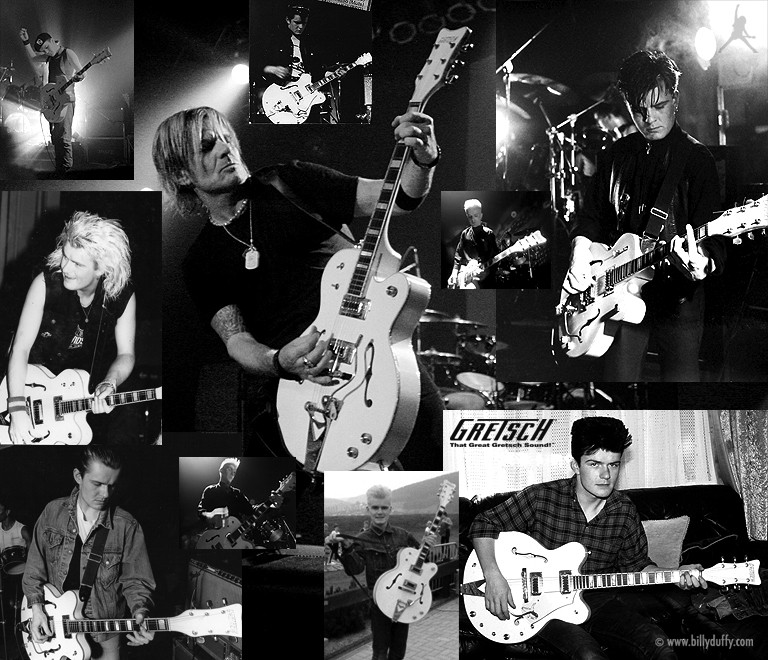For guitar aficionados, certain instruments become synonymous with the artists who wield them. In the case of Billy Duffy, the iconic guitarist of The Cult, no guitar is more closely linked to his image and sound than the Gretsch White Falcon. Since acquiring his first White Falcon in the early 1980s, this guitar has reigned supreme in Duffy’s collection, captivating audiences with its distinctive look and sound.
 Billy Duffy Gretsch White Falcon Guitar
Billy Duffy Gretsch White Falcon Guitar
Duffy’s fascination with the White Falcon wasn’t a fleeting fancy; it was a gradual yet persistent attraction. “My love affair with the White Falcon was a long-term/short-term thing,” Duffy explains. Tracing back to his pre-punk rock days around 1976, his musical tastes were shaped by the sounds of Neil Young and Ted Nugent. Witnessing Nugent perform with a large Byrdland guitar left a lasting impression. “I was very impressed by the large, semi-acoustics. They were more exotic,” he recalls, even while still appreciating the classic Les Paul.
The quest for a unique sonic identity led Duffy towards Gretsch guitars. The pivotal moment arrived when he saw Matthew Ashman of Bow Wow Wow playing a Gretsch. “Seeing Matthew Ashman with that Gretsch… I was transfixed,” Duffy admits. This experience solidified his desire: “I said, ‘If I get any money, I’m buying a Gretsch.’”
Fate intervened when Duffy joined Theatre Of Hate. Ironically, the band’s singer also played a Gretsch, an “odd-green model.” When asked about his guitar choice, Duffy’s response was decisive: “Well, I’ve got a job now, don’t I? I’m buying a Gretsch!” Investing his earnings, he acquired a double cutaway White Falcon, marking the beginning of his long-term relationship with this exceptional instrument.
Despite his immediate connection to the feel of the guitar, owning a Gretsch in 1981 was a significant financial undertaking. Imported from the US to the UK, Gretsch guitars were considered expensive. “Of course, I didn’t have any special backing then, so as you can imagine, buying a guitar like that was a really big deal for me.”
His first White Falcon, a double cutaway stereo model, presented some practical challenges. “The only White Falcon I could get my hands on at the time was a double cutaway that was stereo, which made it difficult to use – I had to get a stereo jack for it.” Seeking a more streamlined setup, he later acquired a single cutaway mono version. This became the White Falcon most fans recognize. “It was easier for me to handle, too. I didn’t like the stereo guitar too much; I don’t know what it was made for – some kind of country-jazz-fusion thing, I guess. But I wanted to rock, so the other one suited me fine.”
Duffy emphasizes the dual appeal of Gretsch guitars. “Gretsch’s are great. They’ve got their sound, obviously, but there’s the look – it’s distinctive. You strap on a Gretsch, and you’re saying something with how you look. The visual thing is very important in rock ‘n’ roll. A Gretsch is a fashion statement, as well as an instrument for sound.” The White Falcon, in particular, embodies this blend of aesthetic grandeur and sonic character.
Beyond its striking appearance, Duffy was drawn to the unique sound of the Gretsch. He actively experimented to shape his sonic vision. “They do look cool but the distinctive sound is really important to me and it’s something I’ve really experimented with. I’ve tried to go for something… cinematic.” Rejecting typical Gretsch associations like surf or rockabilly, and even Ennio Morricone’s style, Duffy aimed for a “psychedelic” feel. “It’s a feeling I pursued, and I still am.”
Over the years, Duffy has customized his White Falcons to refine their sound. Initially, he addressed the pickups, which he found lacking in output in his 1970s models. “I changed the pickups initially in the ‘80s because the output was so feeble, so Seymour Duncan helped me – I’ve been working with him since 1986.” His goal was to enhance the guitar’s versatility, retaining the signature Gretsch “chime” while adding a Les Paul-esque “chunk” in the lower frequencies. “I wanted to keep all of the high end “chime” of a Gretsch, but with the lower end chunk of a Les Paul.” Seymour Duncan installed custom pickups in his vintage White Falcons to achieve this. Duffy notes that contemporary TV Jones pickups, available through Gretsch, now offer a similar solution straight from the factory. “Nowadays, the TV Jones pickups you get through Gretsch do the same thing just fine.”
Playing semi-acoustic guitars like the White Falcon often presents feedback challenges, especially at stage volumes. Duffy developed practical techniques to manage this. “With every semi-acoustic you have some feedback potential. I put some stuff – t-shirts and things – in the guitar, but not too much; you don’t want to affect the tone.” This method, along with careful monitoring, allows him to control feedback effectively. “You just have to watch it, because there are those low-end notes that will send feedback through the roof if you’re not careful.”
Billy Duffy’s journey with the Gretsch White Falcon is a testament to the enduring appeal of this exceptional guitar. From its visual presence to its distinctive voice, the White Falcon has become an integral part of Duffy’s artistry, shaping his sound and solidifying his iconic status in rock music. His personal modifications and ongoing exploration of its sonic possibilities demonstrate a deep and lasting commitment to this legendary instrument.
